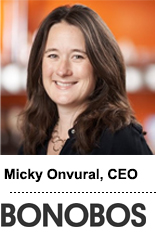 The online clothing retailer Bonobos is at the center of upheaval in US retail and ecommerce. The company was acquired by Walmart last year for $310 million last year and has opened 58 brick-and-mortar stores in the past five years.
The online clothing retailer Bonobos is at the center of upheaval in US retail and ecommerce. The company was acquired by Walmart last year for $310 million last year and has opened 58 brick-and-mortar stores in the past five years.
Bonobos also exemplified the direct-to-consumer category in September when former CMO Micky Onvural was promoted to CEO.
“The conversations going on in every business right now, not just DTC, is ‘Who is our consumer?’ and ‘How do we serve them?’” Onvural told AdExchanger. “Historically that’s been the preserve of the marketer and why I think many DTC companies feel more marketing-led.”
AdExchanger spoke with Onvural about her growth strategy for Bonobos and how the company’s marketing will change as it adds stores and searches for audiences outside its online base.
AdExchanger: What’s different since the Walmart deal?
MICKY ONVURAL: Very little changes to be honest. One of the reasons Walmart bought us was to understand disruptive, direct brands. We’ve been able to leverage their buying power and things like shipping fees or credit card fees. But it’s more about how we lean into our core value proposition.
What’s your share of business between ecommerce and store sales?
We’re about 70% ecommerce right now. It changes naturally as we evolve and add more stores, but I’d say you can expect that split to remain in the same kind of ratio, with majority online sales.
We’re in a fortunate position where we have the data from our ecommerce business that we can bring together with our retail data and data from our partnership with Nordstrom. But that ratio doesn’t change dramatically because having the store data and presence lifts the ecommerce numbers too.
How has the marketing mix changed?
That’s evolved over time too. But we don’t think about it like there’s brand marketing and there’s direct response marketing. It’s about making sure you’re thinking about all the touchpoints.
Our shops for instance we consider a big part of our marketing mix. That’s a massive experiential marketing play and a billboard. And we’re starting to understand how that plays into our upper funnel activity.
In terms of raw investment you could say what’s changing most right now in our marketing mix is our store footprint.
How does retail expansion impact digital campaigns?
We think about how we leverage our stores on top of the normal social and search efforts. And whether there’s a store may change the amount you need to spend on search to drive awareness or whether it makes sense to advertise with Yelp, say.
Expanding our retail footprint also makes our multi-touch attribution (MTA) more critical. Having the in-house MTA technology is a differentiator for our customer experience because it’s plugged in to how we understand repeat business, brand loyalty and higher cart sizes.
Is television a growing part of the media plan?
We did our first substantial TV test this year in Chicago and Austin and a national campaign with the ESPYs (The annual ESPN sports awards) this summer. We saw lift in the Austin and Chicago stores and markets overall, though it’s not new that with a spike in brand awareness you see efficiencies in direct response channels.
We’ll do more broad awareness campaigns, but the early work is focused on markets where we have stores and can put that data to work. For us these tests aren’t about about macro strategy. We want granular answers about the return on investment when you have the interplay of TV and digital and the period of time in-market when that heightened ROI pays off.
Many DTC companies are trying TV because they need to grow beyond their online audiences and lookalikes. Is that a focus for Bonobos?
The focus is always on growing your addressable market. We’re fortunate in the sense that there are 17 million American men who make $100,000 or more per year and shop online. Getting into big and tall fittings was a way of expanding our addressable audience. We’re also thinking about how we can bring women into the brand. Women who purchase for men is an important segment we’re developing.
I agree many direct brands are making an uncomfortable transition or are boxed into a specific audience on one or two social channels. We’ve made defensible investments to open new markets.
This post was syndicated from Ad Exchanger.


More Stories
Marketing Morsels: Hidden Valley Ranch, La-Z-Boy, Topps & More
Flashback: Jane Pauley and Deborah Norville Revisit Today’s 1989 Succession Drama
Ally Financial Revives ‘Banksgiving’ With A TikTok Twist